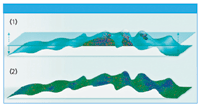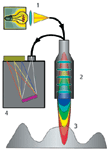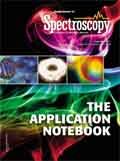Topographic Confocal Raman Imaging using True Surface Microscopy
Application Notebook
True surface microscopy for topographic confocal Raman imaging adds optical profilometer functionality to a highly sensitive confocal Raman microscope. Using this profilometer function, topographic scans of several square millimeters can be acquired, similar to a very large AFM topography image. This acquired large-area topography image can be used to trace the surface contours while acquiring a confocal Raman image.
True surface microscopy for topographic confocal Raman imaging adds optical profilometer functionality to a highly sensitive confocal Raman microscope. Using this profilometer function, topographic scans of several square millimeters can be acquired, similar to a very large AFM topography image. This acquired large-area topography image can be used to trace the surface contours while acquiring a confocal Raman image.
A wide variety of Raman Imaging applications greatly benefit from a confocal setup (1), and depth scans as well as 3D images are only possible due to high confocality (2) especially when combined with diffraction-limited lateral resolution. On rough or inclined samples, however, such a high level of confocality can cause part of the scanned area to be out of focus. This is especially true for larger scans on the mm scale because it can become quite a challenge to achieve a flatness of only a few µm over such a large area. Decreasing the confocality and thus making the system less sensitive to variations due to a lower depth resolution is a solution if the topographic changes are small (for example <10 µm), but even in those cases it is not desirable due to the loss in surface sensitivity.

Figure 1: (1): Confocal Raman imaging on large samples (mm-size) delivers an optical cross-section through the sample. If the sample is not transparent, only the intersection of focal plane and sample surface will give a Raman signal. Depending on the objective used, the focal plane might have a thickness of less than 1 µm. (2) The true surface microscopy option enables the precise tracing of the surface while acquiring Raman imaging data, resulting in a true surface Raman image.
Especially when looking at intensity changes of peaks or when working with transparent samples, this option should be avoided. However, without such a compromise or if the topographic variation is too large, it is only possible to image a slice of the sample in one scan in conventional Confocal Raman Imaging systems (Figure 1.1). For samples with high optical density for the wavelength of choice (= low penetration depth) one could in this fashion acquire many slices and then reconstruct the surface, but this would be a very time consuming procedure. Confocal Raman Imaging in combination with true surface microscopy on the contrary allows the user to remain in focus on the surface at every point and thus acquire the complete image in one scan (Figure 1.2). True Surface microscopy uses the principle of a confocal chromatic sensor as shown in Figure 2. Scanning the sample in the XY plane reveals a topographic map of the sample. Such a map can be followed in a subsequent confocal Raman image scan so that the Raman excitation is always kept in focus with the sample surface (or at any chosen distance below the surface).

Figure 2: The functionality of a confocal chromatic sensor. White light (1) is focused through a hyperchromatic lens system (2) onto the sample (3) and only the light scattered in its focal plane reaches the spectrometer (4) with high intensity (yellow in the example shown here).
Results
In order to illustrate the advantage of such a sensor a highly inclined and very rough geological sample was investigated with true surface microscopy. A photograph of the sample (Josefsdal Chert 99SA07, courtesy of Frances Westall, CNRS Orleans, France) can be seen in Figure 3.1 and the result of the topographic measurement in Figure 3.2. The scanned area was 2 × 2 mm with a maximum topographic range in the scanned area of approximately 1.3 mm. If such an area is scanned in confocal Raman imaging mode without correction of the topography only a very limited range can be recorded, which is illustrated in Figure 3.3. The same area was also scanned with the topographic data taken into account in order to adjust the Z-position at each image pixel such that the surface is in focus. The results (Figure 3.4) clearly show much more detailed information of the sample surface. The colors in Figure 3.3 and 3.4 match the colors of the corresponding spectra shown in Figure 3.5. Quartz (blue), kerogen (green) as well as anatase (red) could be found in this sample. Areas marked in yellow indicate high levels of fluorescence. The confocal Raman images were generated using single- as well as multivariate data analysis methods as example described in (1).

Figure 3
Conclusion
Combining true surface microscopy with confocal Raman microscopy allows for the first time the investigation of irregularly shaped surfaces with high confocality. Sample preparation which may require a substantial amount of time and experimental know-how in order to avoid unwanted artifacts, is reduced to a minimum. Samples that previously could not be recorded because they could not be prepared in the required way due to sample destruction are now also accessible for large area confocal Raman microscopy.

Figure 4: Corresponding spectra of the mineral phases: blue: quartz, green: kerogen, red: anatase.
References
(1) T. Dieing, O. Hollricher, and J. Toporski, Eds., Confocal Raman Imagingm (Springer, Berlin/Heidelberg, 2010).
(2) http://www.witec.de/en/download/Raman/WITec_3DRamanImaging.pdf.
WITec Instruments Corp.
122 McCammon Ave., Maryville, TN 37804
tel. (865) 984-4445, fax (865) 984-4441
Email: info@witec-instruments.com
Website: www.WITec-Instruments.com

Thermo Fisher Scientists Highlight the Latest Advances in Process Monitoring with Raman Spectroscopy
April 1st 2025In this exclusive Spectroscopy interview, John Richmond and Tom Dearing of Thermo Fisher Scientific discuss the company’s Raman technology and the latest trends for process monitoring across various applications.
A Seamless Trace Elemental Analysis Prescription for Quality Pharmaceuticals
March 31st 2025Quality assurance and quality control (QA/QC) are essential in pharmaceutical manufacturing to ensure compliance with standards like United States Pharmacopoeia <232> and ICH Q3D, as well as FDA regulations. Reliable and user-friendly testing solutions help QA/QC labs deliver precise trace elemental analyses while meeting throughput demands and data security requirements.